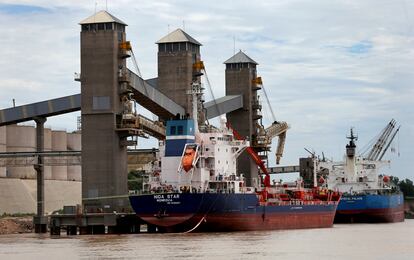The Paraná River, the second longest in South America, suffers a historical drought due to the lack of rainfall.
Its flow registers the minimum values of the last more than 70 years from its birth, in Brazil, to its mouth in Argentina and also as it passes through Paraguay.
In Argentina, the Government of Alberto Fernández this week declared a water emergency for 180 days to mitigate the serious economic and environmental consequences of the drop in water levels.
The decrease in its flow hinders exports, power generation and increases the risk of fires.
The Paraná is the main exit route for grains and agro-industrial products from Argentina. In some 70 kilometers of coastline around the city of Rosario there are about thirty port terminals from which soy, corn, flour, oil and fuel are exported, among others. Every year, around 2,500 large ships transport them from there to the rest of the world, but for months their maximum load capacity has been reduced by 10% due to the decrease in depth in critical passages, explains Alfredo Sese, Technical Secretary of the Transportation Commission of the Rosario Stock Exchange (BCR).
The data registered by the National Water Institute show the low flow of the Paraná, below 6,000 cubic meters per second. At the height of Rosario, the river has already dropped more than three meters from its usual level in winter. On July 25, its height was -0.17 meters, compared to an average of 3.2 meters. These are the lowest values of the last 77 years. “That the river has a low height or that the values are negative does not mean that the river is dry. The Paraná is a wide and deep river ”, Sese points out. The measurement is made in the port of Rosario, not in the center of the river, and the zero point is an agreed standard value based on the minimum values of a historical series.
However, in its bed there are dunes that form mounds, known as critical passages.
From the average depth of 10.3 meters, in some cases the waters dropped to 9.7 meters, which prevents ships from leaving with the full load and increases the cost per ton.
Cargo port terminal near Rosario Marcos Brindicci / Reuters
According to the BCR, the losses for the agro-export sector between March and August will be around 315 million dollars.
The exceptional situation, which is expected to be extended for several more months, has forced exporters to look for alternative cargo routes, such as Bahía Blanca, on the southern coast of the country, where the volume of corn cargo increased by 21% in this 2021 period compared to the same of the previous year.
Join EL PAÍS now to follow all the news and read without limits
Subscribe here
The lower flow of the Paraná has not caused water restrictions in Argentine homes for now, but it does complicate the generation of electricity.
The Yacyretá power plant, shared between Paraguay and Argentina, operates at 50% of its capacity and the nuclear power plants in Zárate (85 kilometers north of Buenos Aires) have had to hire a dredger to guarantee the availability of water for their operation.
Fire watch
The Government also closely monitors the wetlands on the islands and margins of the Paraná due to the high risk of fires due to the lack of water. The objective is to avoid a prohibited practice, but still not eradicated among producers: the burning of pastures and the subsequent formation of embankments to gain land from the river and be able to use it for cattle ranching. In 2020, nearly 300,000 hectares of the Paraná delta were burned, mostly due to arson.
The Environment Ministry plans to install state-of-the-art smoke and heat detection cameras to identify the bulbs as soon as they appear.
“We are facing an environmental problem that is multi-causal, a climate change scenario, a drought that has lasted a year and a half, an unprecedented downspout.
On this scenario, productive 'actions' are mounted that negatively enhance this phenomenon: the felling of native forests, the clearing in the upper Paraná basin (the Amazon), ”said the Deputy Minister of the Environment, Sergio Federovisky, to the newspaper
Página 12
.
"The loss of wetlands, those ecosystems whose environmental service was to retain water and release it when necessary ... It has been said ad nauseam that wetlands function like sponges.
Well, to put it bluntly, those sponges disappeared. "
The return to normality is not imminent. According to the latest report from the National Water Institute, "the downward trend observed will continue in the coming weeks, with a very high probability that the downward trend will persist during winter and possibly a similar trend in the last quarter of the year."

